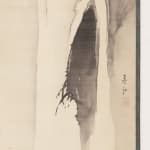-
Artworks




Ranko Nakai (1766-1830)
Waterfall, late 1700ssumi ink on paper43” x 14” ; scroll, 76” x15”Further images
The waterfall is one of the subjects which has been painted by many artists throughout the history of Japanese art. Some depicted the subject from afar, while others showed it...The waterfall is one of the subjects which has been painted by many artists throughout the history of Japanese art. Some depicted the subject from afar, while others showed it as if standing below and looking up at it. In Nakai, Ranko’s painting, however, it is challenging to find the artist's vantage point. Perhaps he did not paint a specific waterfall located among certain mountains. Instead, he painted the memory of “waterfall,” or a waterfall that he “saw" in a poem with his mind’s eye. Perhaps Ranko’s sense of visual poetics stemmed from the reality that he was an excellent poet in his own right.
About the Artist:
Nakai, Ranko (1766 -1830) after learning painting under Shitomi, Kangetsu (1747 - 1797), and studying old masterworks by Sesshu Toyo (1420 - 1506) and Muqui Fachang(牧谿)(1210? - 1269?), found his place in the Shijo school of art. He was also an excellent poet. When he was active (the late 1700s - early 1800s) a school called Kaitoku-do was established and operated in Osaka. Even though the primary goal of Kaitoku-do was to provide moral education for merchants based on the ChineseChu Hsi school of philosophy(朱子学) the full range of its lectures included Chinese poetry, Japanese literature, visual art, or even lectures on science and anatomy. It was a very forward-looking and advanced school in the period. In consequence, many notable scholars, poets, and artists gathered around the school and exchanged their knowledge, skills, and ideas after they gave lectures. Ranko was one of them. The congregation of the leaders in various genres influenced each other to expand their perspective and lead them to novel intellectual maturity. This growth is evident in Ranko’s works, too, through his rich and poetic perception of nature and his calligraphic brush strokes.
Signup for our Newsletter
You will receive two emails a month from us. One introduces artworks and design works from Kyoto's hidden sources and the other is stories from Misako, sharing insights into Japanese culture.
* denotes required fields
为了回应您的查询,我们将根据我们的隐私政策处理您提供的个人数据。







